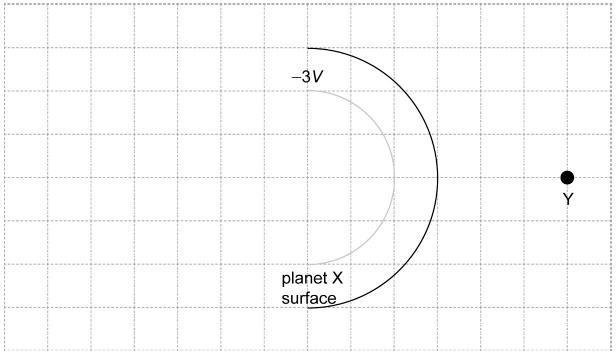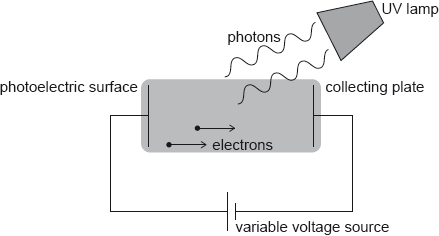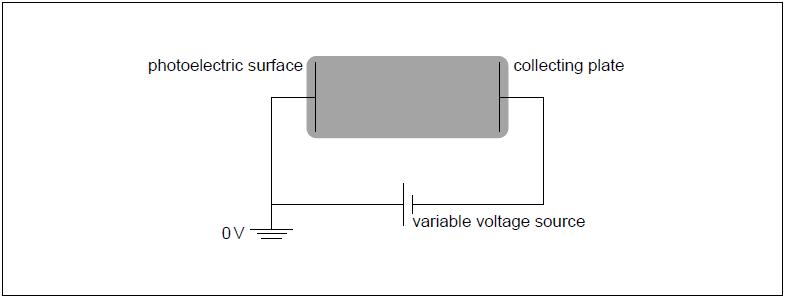
Topic 10 - Fields & Potential
Question 1
HLPaper 2Titan is a moon of Saturn. The Titan-Sun distance is times greater than the Earth-Sun distance.
The molar mass of nitrogen is .
Show that the intensity of the solar radiation at the location of Titan is .
Titan has an atmosphere of nitrogen. The albedo of the atmosphere is 0.22. The surface of Titan may be assumed to be a black body. Explain why the average intensity of solar radiation absorbed by the whole surface of Titan is .
Show that the equilibrium surface temperature of Titan is about .
The mass of Titan is 0.025 times the mass of the Earth and its radius is 0.404 times the radius of the Earth. The escape speed from Earth is 11.2 km/s. Show that the escape speed from Titan is 2.8 km/s.
The orbital radius of Titan around Saturn is and the period of revolution is .
Show that where is the mass of Saturn.
The orbital radius of Titan around Saturn is m and the orbital period is 15.9 days. Estimate the mass of Saturn.
Show that the mass of a nitrogen molecule is kg.
Estimate the root mean square speed of nitrogen molecules in the Titan atmosphere. Assume an atmosphere temperature of .
Discuss, by reference to the answer in (b), whether it is likely that Titan will lose its atmosphere of nitrogen.
Question 2
HLPaper 2Explain what is meant by the gravitational potential at the surface of a planet.
An unpowered projectile is fired vertically upwards into deep space from the surface of planet Venus. Assume that the gravitational effects of the Sun and the other planets are negligible.
The following data are available.
- Mass of Venus = kg
- Radius of Venus = m
- Mass of projectile = kg
- Initial speed of projectile =
(i) Determine the initial kinetic energy of the projectile.
(ii) Describe the subsequent motion of the projectile until it is effectively beyond the gravitational field of Venus.
Question 3
HLPaper 1The escape speed from a planet of radius is . A satellite orbits the planet at a distance from the surface of the planet.
What is the orbital speed of the satellite?
Question 4
HLPaper 2A metal sphere is charged positively and placed far away from other charged objects. The electric potential at a point on the surface of the sphere is 53.9 kV.
A small positively charged object moves towards the centre of the metal sphere. When the object is 2.8 m from the centre of the sphere, its speed is 3.1 m s. The mass of the object is 0.14 g and its charge is 2.4 × 10 C.
Outline what is meant by electric potential at a point.
The electric potential at a point a distance from the centre of the sphere is . Determine the radius of the sphere.
Comment on the angle at which the object meets equipotential surfaces aroundthe sphere.
Determine whether the object will reach the surface of the sphere.
Show that the kinetic energy of the object is about .
Question 5
HLPaper 1An isolated hollow metal sphere of radius carries a positive charge.
Which graph shows the variation of potential with distance from the centre of the sphere?

Question 6
HLPaper 2The diagram shows the gravitational field lines of planet X.

Outline how this diagram shows that the gravitational field strength of planet X decreases with distance from the surface.
The diagram shows part of the surface of planet X. The gravitational potential at the surface of planet X is and the gravitational potential at point Y is .

Sketch on the grid the equipotential surface corresponding to a gravitational potential of .
A meteorite, very far from planet X begins to fall to the surface with a negligibly small initial speed. The mass of planet X is kg and its radius is m. The planet has no atmosphere. Calculate the speed at which the meteorite will hit the surface.
Question 7
HLPaper 2Hydrogen atoms in an ultraviolet (UV) lamp make transitions from the first excited state to the ground state. Photons are emitted and are incident on a photoelectric surface as shown.

The photons cause the emission of electrons from the photoelectric surface. The work function of the photoelectric surface is 5.1 eV.
The electric potential of the photoelectric surface is 0 V. The variable voltage is adjusted so that the collecting plate is at V.

Show that the energy of photons from the UV lamp is about .
Calculate, in J, the maximum kinetic energy of the emitted electrons.
Suggest, with reference to conservation of energy, how the variable voltage source can be used to stop all emitted electrons from reaching the collecting plate.
The variable voltage can be adjusted so that no electrons reach the collecting plate. Write down the minimum value of the voltage for which no electrons reach the collecting plate.
On the diagram, draw and label the equipotential lines at V and V.
An electron is emitted from the photoelectric surface with kinetic energy eV. Calculate the speed of the electron at the collecting plate.
Question 8
HLPaper 2In a classical model of the singly-ionized helium atom, a single electron orbits the nucleus in a circular orbit of radius r.

The Bohr model for hydrogen can be applied to the singly-ionized helium atom. In this model the radius* , in m, of the orbit of the electron is given by -11 ×
Show that the speed of the electron with mass , is given by a(i).
Hence, deduce that the total energy of the electron is given by .
a(ii).
In this model the electron loses energy by emitting electromagnetic waves. Describe the predicted effect of this emission on the orbital radius of the electron. a(iii).
Show that the de Broglie wavelength of the electron in the state is m.
The formula for the de Broglie wavelength of a particle is . b(i).
Estimate for , the ratio .
State your answer to one significant figure.
b(ii).
The description of the electron is different in the Schrodinger theory than in the Bohr model. Compare and contrast the description of the electron according to the Bohr model and to the Schrodinger theory.
Question 9
HLPaper 1Two point charges are at rest as shown.
At which position is the electric field strength greatest?

Question 10
HLPaper 1A charged sphere in a gravitational field is initially stationary between two parallel metal plates. There is a potential difference between the plates.

Three changes can be made:
- I. Increase the separation of the metal plates
- II. Increase
- III. Apply a magnetic field into the plane of the paper
What changes made separately will cause the charged sphere to accelerate?
